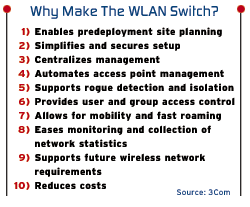146hed_access1.gif|59|480|

hen it comes to WLAN architecture, the long-standing debate of “fat vs. thin” is over: Thin is most definitely in.
The argument is perhaps a familiar one. Early entrants into the wireless market built “fat” stand-alone access points (APs) with all of the intelligence built in. The fat architecture uses APs that handle everything from radio frequency (RF) communication to user authentication and encryption, and it represents the majority of WLAN deployments today. But as Wi-Fi installations multiplied, it became apparent that a WLAN comprised of hundreds of APs posed serious management challenges.
Enter the “thin” architecture, which teams stripped-down APs with WLAN switches. Thin APs provide little more than RF communication; under a variation known as “fit” APs, they handle both RF communication and encryption. The rest of the heavy lifting is handled by a WLAN switch, a wired network switch that has knowledge of and centralized control over the APs connected to it.
Initially the domain of upstart wireless vendors such as Airespace, Aruba Wireless Networks and Trapeze Networks, WLAN switches have now caught on as the architecture of choice among more established players such as 3Com, Alcatel and Nortel Networks, which are all now OEMing them from startups. Research firm In-Stat/MDR expects the total WLAN switch market to grow to roughly 242,500 units shipping in 2009 from about 35,800 units shipped in 2004.
Once one of the thin wireless architecture’s most vocal opponents, Cisco Systems blessed the approach through its purchase in March of WLAN switch vendor Airespace, eradicating any lingering doubts that the technology was ready for prime time. Cisco now offers both its newly purchased WLAN switch portfolio and its existing wireless product lineup of stand-alone APs (see news story, page 4).
While there’s still a learning curve for customers, solution providers said little question remains as to which architecture best meets the needs of all but the most basic Wi-Fi customers. By providing centralized management, better network intelligence and faster roaming, the thin WLAN architecture can help cut costs, boost security and offer better support for emerging technologies such as Voice over WLAN (VoWLAN), they said.
Stand-alone APs are just a stepping stone on the path of WLAN advancement that are now giving way to the next technology generation, solution providers said.
“Fat APs are literally just part of the evolution of wireless,” said John Lowery, CEO of Intelesys, a Madison Heights, Mich.-based solution provider.
For many customers, the deciding factor in the fat vs. thin debate is the emergence of wireless VoIP, he said. “Everyone wants it,” Lowery said. “Customers want a way to get the phones off their desks.”

As more and more businesses prepare for VoWLAN deployments, thin APs clearly win, Lowery said. “You can’t roam with fat APs and wireless voice. The calls would drop,” he said.
Through a WLAN switch, thin or fit APs are in better communication with each other and can deliver the fast roaming needed to support VoWLAN applications, said Brent Nixon, director of product management for wireless systems at 3Com, Marlborough, Mass.
“With fit APs, when a client starts to roam, the APs are ready for it,” Nixon said. “In a fat environment, whenever you cross a subnet you get a new IP address. That requires reauthentication.”
The delay caused by such security measures might be virtually imperceptible to a notebook PC user processing data but unforgivable to that same user if he’s trying to conduct a wireless VoIP call, said John Freres, president of Meridian IT Solutions, Schaumburg, Ill.
“Voice is less forgiving than data. You need to make sure there’s seamless compatibility [in the WLAN],” Freres said.
Other advantages of a WLAN switch environment include easier setup and deployment, improved rogue detection, and support for user and group access control, said 3Com’s Nixon.
3Com currently OEMs a WLAN switch and fit AP portfolio from Trapeze, Pleasanton, Calif. It continues to offer its own portfolio of fat APs, though sales of the latter are expected to decline, Nixon said.
The vendor is now working on an upgrade path that will enable its legacy APs to be centrally managed by a WLAN switch, he said.
It’s a strategy other vendors are embracing as well.
Enterasys Networks, Andover, Mass., later this year plans to offer a software upgrade that will enable its fat APs to be managed centrally by its recently introduced WLAN switch line. Cisco is working toward the same end.
But just because the debate is dead doesn’t mean fat APs are altogether extinct. While they may no longer be the contender of choice for larger WLAN deployments, they can still represent a better fit for smaller deployments where there would be too few APs to cause management concerns or to justify the up-front cost of a WLAN switch, said vendors and analysts.
“Thin APs with intelligence in the switch is not always the right answer,” said Alex Thurber, director of security and wireless for worldwide channels at Cisco, San Jose, Calif. “For smaller organizations or those with very distributed branch offices, it can get very expensive.”
So with WLAN switch deployments heralded as the best path for enterprise deployments and fat APs held up as the better choice for smaller customers, the industry is gearing up for a new debate: Should WLAN switches operate as separate network devices or should control over thin APs be built directly into network switches? It’s a question vendors are now mulling.
“As WLAN management functionality is increasingly integrated into wired Ethernet switches, the price difference between a wired Ethernet switch with WLAN management functionality and a switch without such functionality could become small enough that substantially all new enterprise Ethernet switches sold will be capable of managing APs,” said Sam Lucero, In-Stat/MDR analyst, in a recent report.
The debate is dead. Long live the debate.